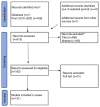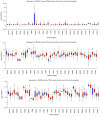Clinical significance of P-class pumps in cancer
- PMID: 34386080
- PMCID: PMC8298992
- DOI: 10.3892/ol.2021.12919
Clinical significance of P-class pumps in cancer
Abstract
P-class pumps are specific ion transporters involved in maintaining intracellular/extracellular ion homeostasis, gene transcription, and cell proliferation and migration in all eukaryotic cells. The present review aimed to evaluate the role of P-type pumps [Na+/K+ ATPase (NKA), H+/K+ ATPase (HKA) and Ca2+-ATPase] in cancer cells across three fronts, namely structure, function and genetic expression. It has been shown that administration of specific P-class pumps inhibitors can have different effects by: i) Altering pump function; ii) inhibiting cell proliferation; iii) inducing apoptosis; iv) modifying metabolic pathways; and v) induce sensitivity to chemotherapy and lead to antitumor effects. For example, the NKA β2 subunit can be downregulated by gemcitabine, resulting in increased apoptosis of cancer cells. The sarcoendoplasmic reticulum calcium ATPase can be inhibited by thapsigargin resulting in decreased prostate tumor volume, whereas the HKA α subunit can be affected by proton pump inhibitors in gastric cancer cell lines, inducing apoptosis. In conclusion, the present review highlighted the central role of P-class pumps and their possible use and role as anticancer cellular targets for novel therapeutic chemical agents.
Keywords: HKA; NKA; P-type ATPases; SERCA; cancer; pump subunits.
Copyright: © Themistocleous et al.
Conflict of interest statement
The authors declare that they have no competing interests.
Figures





References
Publication types
LinkOut - more resources
Full Text Sources
Miscellaneous
